Federico Raue
A Coreset Selection of Coreset Selection Literature: Introduction and Recent Advances
May 23, 2025Abstract:Coreset selection targets the challenge of finding a small, representative subset of a large dataset that preserves essential patterns for effective machine learning. Although several surveys have examined data reduction strategies before, most focus narrowly on either classical geometry-based methods or active learning techniques. In contrast, this survey presents a more comprehensive view by unifying three major lines of coreset research, namely, training-free, training-oriented, and label-free approaches, into a single taxonomy. We present subfields often overlooked by existing work, including submodular formulations, bilevel optimization, and recent progress in pseudo-labeling for unlabeled datasets. Additionally, we examine how pruning strategies influence generalization and neural scaling laws, offering new insights that are absent from prior reviews. Finally, we compare these methods under varying computational, robustness, and performance demands and highlight open challenges, such as robustness, outlier filtering, and adapting coreset selection to foundation models, for future research.
ForAug: Recombining Foregrounds and Backgrounds to Improve Vision Transformer Training with Bias Mitigation
Mar 12, 2025Abstract:Transformers, particularly Vision Transformers (ViTs), have achieved state-of-the-art performance in large-scale image classification. However, they often require large amounts of data and can exhibit biases that limit their robustness and generalizability. This paper introduces ForAug, a novel data augmentation scheme that addresses these challenges and explicitly includes inductive biases, which commonly are part of the neural network architecture, into the training data. ForAug is constructed by using pretrained foundation models to separate and recombine foreground objects with different backgrounds, enabling fine-grained control over image composition during training. It thus increases the data diversity and effective number of training samples. We demonstrate that training on ForNet, the application of ForAug to ImageNet, significantly improves the accuracy of ViTs and other architectures by up to 4.5 percentage points (p.p.) on ImageNet and 7.3 p.p. on downstream tasks. Importantly, ForAug enables novel ways of analyzing model behavior and quantifying biases. Namely, we introduce metrics for background robustness, foreground focus, center bias, and size bias and show that training on ForNet substantially reduces these biases compared to training on ImageNet. In summary, ForAug provides a valuable tool for analyzing and mitigating biases, enabling the development of more robust and reliable computer vision models. Our code and dataset are publicly available at https://github.com/tobna/ForAug.
A Study in Dataset Distillation for Image Super-Resolution
Feb 05, 2025



Abstract:Dataset distillation is the concept of condensing large datasets into smaller but highly representative synthetic samples. While previous research has primarily focused on image classification, its application to image Super-Resolution (SR) remains underexplored. This exploratory work studies multiple dataset distillation techniques applied to SR, including pixel- and latent-space approaches under different aspects. Our experiments demonstrate that a 91.12% dataset size reduction can be achieved while maintaining comparable SR performance to the full dataset. We further analyze initialization strategies and distillation methods to optimize memory efficiency and computational costs. Our findings provide new insights into dataset distillation for SR and set the stage for future advancements.
Distill the Best, Ignore the Rest: Improving Dataset Distillation with Loss-Value-Based Pruning
Nov 18, 2024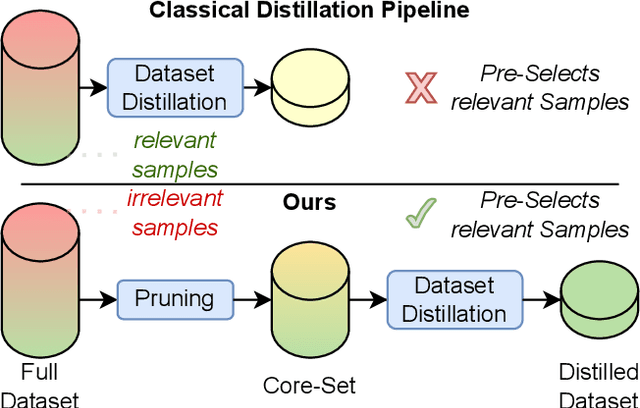

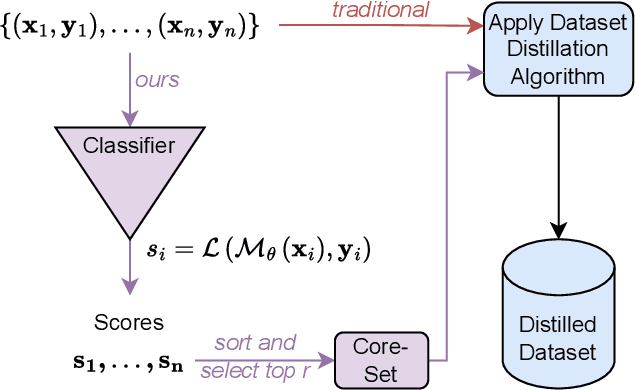
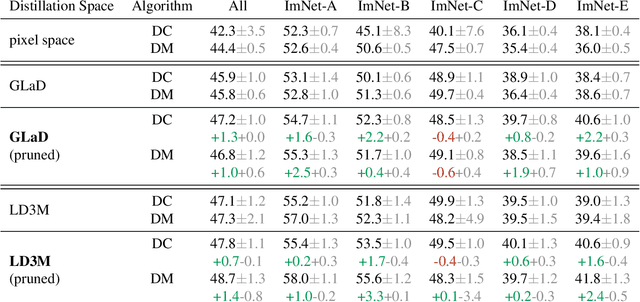
Abstract:Dataset distillation has gained significant interest in recent years, yet existing approaches typically distill from the entire dataset, potentially including non-beneficial samples. We introduce a novel "Prune First, Distill After" framework that systematically prunes datasets via loss-based sampling prior to distillation. By leveraging pruning before classical distillation techniques and generative priors, we create a representative core-set that leads to enhanced generalization for unseen architectures - a significant challenge of current distillation methods. More specifically, our proposed framework significantly boosts distilled quality, achieving up to a 5.2 percentage points accuracy increase even with substantial dataset pruning, i.e., removing 80% of the original dataset prior to distillation. Overall, our experimental results highlight the advantages of our easy-sample prioritization and cross-architecture robustness, paving the way for more effective and high-quality dataset distillation.
Just Leaf It: Accelerating Diffusion Classifiers with Hierarchical Class Pruning
Nov 18, 2024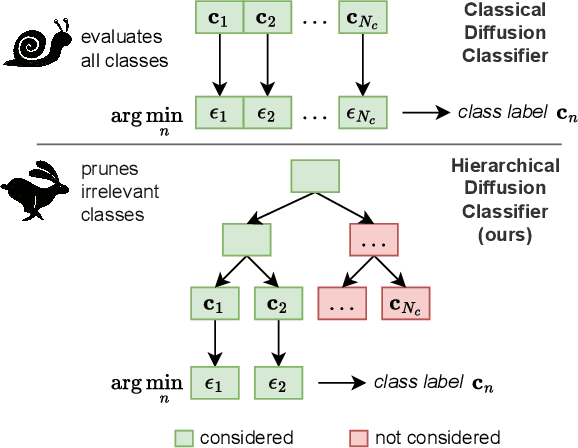

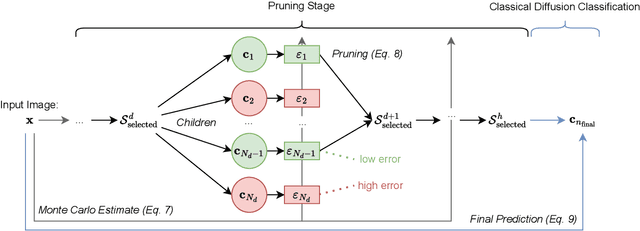

Abstract:Diffusion models, known for their generative capabilities, have recently shown unexpected potential in image classification tasks by using Bayes' theorem. However, most diffusion classifiers require evaluating all class labels for a single classification, leading to significant computational costs that can hinder their application in large-scale scenarios. To address this, we present a Hierarchical Diffusion Classifier (HDC) that exploits the inherent hierarchical label structure of a dataset. By progressively pruning irrelevant high-level categories and refining predictions only within relevant subcategories, i.e., leaf nodes, HDC reduces the total number of class evaluations. As a result, HDC can accelerate inference by up to 60% while maintaining and, in some cases, improving classification accuracy. Our work enables a new control mechanism of the trade-off between speed and precision, making diffusion-based classification more viable for real-world applications, particularly in large-scale image classification tasks.
Zoomed In, Diffused Out: Towards Local Degradation-Aware Multi-Diffusion for Extreme Image Super-Resolution
Nov 18, 2024



Abstract:Large-scale, pre-trained Text-to-Image (T2I) diffusion models have gained significant popularity in image generation tasks and have shown unexpected potential in image Super-Resolution (SR). However, most existing T2I diffusion models are trained with a resolution limit of 512x512, making scaling beyond this resolution an unresolved but necessary challenge for image SR. In this work, we introduce a novel approach that, for the first time, enables these models to generate 2K, 4K, and even 8K images without any additional training. Our method leverages MultiDiffusion, which distributes the generation across multiple diffusion paths to ensure global coherence at larger scales, and local degradation-aware prompt extraction, which guides the T2I model to reconstruct fine local structures according to its low-resolution input. These innovations unlock higher resolutions, allowing T2I diffusion models to be applied to image SR tasks without limitation on resolution.
A Low-Resolution Image is Worth 1x1 Words: Enabling Fine Image Super-Resolution with Transformers and TaylorShift
Nov 15, 2024Abstract:Transformer-based Super-Resolution (SR) models have recently advanced image reconstruction quality, yet challenges remain due to computational complexity and an over-reliance on large patch sizes, which constrain fine-grained detail enhancement. In this work, we propose TaylorIR to address these limitations by utilizing a patch size of 1x1, enabling pixel-level processing in any transformer-based SR model. To address the significant computational demands under the traditional self-attention mechanism, we employ the TaylorShift attention mechanism, a memory-efficient alternative based on Taylor series expansion, achieving full token-to-token interactions with linear complexity. Experimental results demonstrate that our approach achieves new state-of-the-art SR performance while reducing memory consumption by up to 60% compared to traditional self-attention-based transformers.
FedAD-Bench: A Unified Benchmark for Federated Unsupervised Anomaly Detection in Tabular Data
Aug 08, 2024Abstract:The emergence of federated learning (FL) presents a promising approach to leverage decentralized data while preserving privacy. Furthermore, the combination of FL and anomaly detection is particularly compelling because it allows for detecting rare and critical anomalies (usually also rare in locally gathered data) in sensitive data from multiple sources, such as cybersecurity and healthcare. However, benchmarking the performance of anomaly detection methods in FL environments remains an underexplored area. This paper introduces FedAD-Bench, a unified benchmark for evaluating unsupervised anomaly detection algorithms within the context of FL. We systematically analyze and compare the performance of recent deep learning anomaly detection models under federated settings, which were typically assessed solely in centralized settings. FedAD-Bench encompasses diverse datasets and metrics to provide a holistic evaluation. Through extensive experiments, we identify key challenges such as model aggregation inefficiencies and metric unreliability. We present insights into FL's regularization effects, revealing scenarios in which it outperforms centralized approaches due to its inherent ability to mitigate overfitting. Our work aims to establish a standardized benchmark to guide future research and development in federated anomaly detection, promoting reproducibility and fair comparison across studies.
Federated Learning for Blind Image Super-Resolution
Apr 26, 2024



Abstract:Traditional blind image SR methods need to model real-world degradations precisely. Consequently, current research struggles with this dilemma by assuming idealized degradations, which leads to limited applicability to actual user data. Moreover, the ideal scenario - training models on data from the targeted user base - presents significant privacy concerns. To address both challenges, we propose to fuse image SR with federated learning, allowing real-world degradations to be directly learned from users without invading their privacy. Furthermore, it enables optimization across many devices without data centralization. As this fusion is underexplored, we introduce new benchmarks specifically designed to evaluate new SR methods in this federated setting. By doing so, we employ known degradation modeling techniques from SR research. However, rather than aiming to mirror real degradations, our benchmarks use these degradation models to simulate the variety of degradations found across clients within a distributed user base. This distinction is crucial as it circumvents the need to precisely model real-world degradations, which limits contemporary blind image SR research. Our proposed benchmarks investigate blind image SR under new aspects, namely differently distributed degradation types among users and varying user numbers. We believe new methods tested within these benchmarks will perform more similarly in an application, as the simulated scenario addresses the variety while federated learning enables the training on actual degradations.
A Study in Dataset Pruning for Image Super-Resolution
Mar 25, 2024



Abstract:In image Super-Resolution (SR), relying on large datasets for training is a double-edged sword. While offering rich training material, they also demand substantial computational and storage resources. In this work, we analyze dataset pruning as a solution to these challenges. We introduce a novel approach that reduces a dataset to a core-set of training samples, selected based on their loss values as determined by a simple pre-trained SR model. By focusing the training on just 50% of the original dataset, specifically on the samples characterized by the highest loss values, we achieve results comparable to or even surpassing those obtained from training on the entire dataset. Interestingly, our analysis reveals that the top 5% of samples with the highest loss values negatively affect the training process. Excluding these samples and adjusting the selection to favor easier samples further enhances training outcomes. Our work opens new perspectives to the untapped potential of dataset pruning in image SR. It suggests that careful selection of training data based on loss-value metrics can lead to better SR models, challenging the conventional wisdom that more data inevitably leads to better performance.
 Add to Chrome
Add to Chrome Add to Firefox
Add to Firefox Add to Edge
Add to Edge